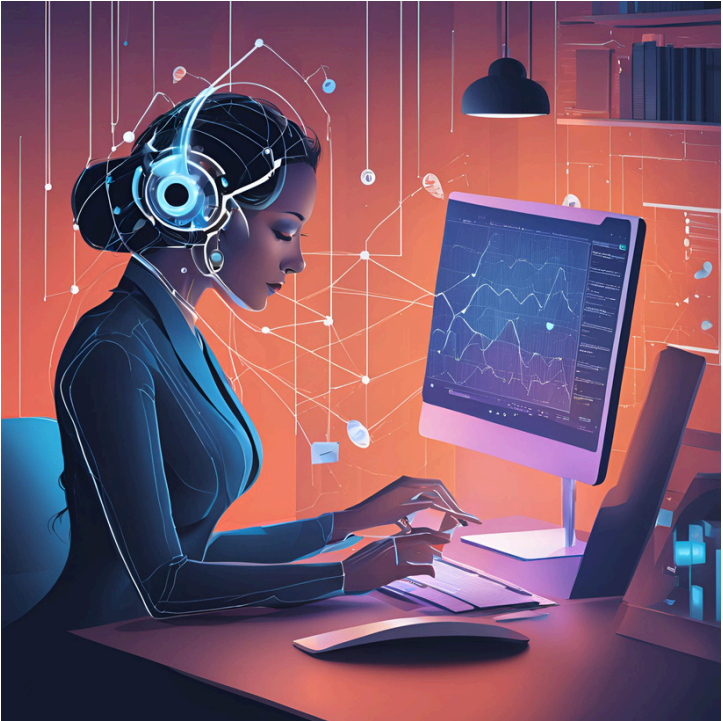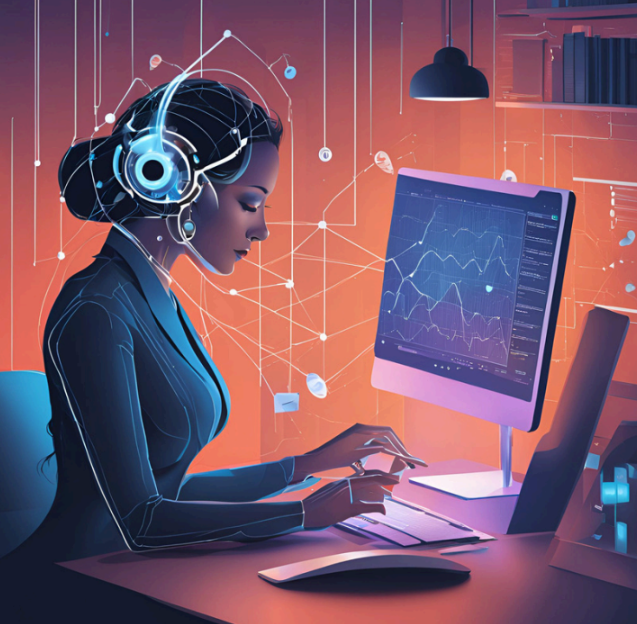
Tired of feeling like you’re lagging behind in the digital age?
Envision a world where AI does the heavy lifting for you, freeing up your time and resources to focus on what truly matters. This isn’t a futuristic fantasy; it’s a reality within reach for anyone willing to embrace the power of artificial intelligence.
This guide will explore the transformative potential of AI across various fields, from virtual assistance and data analysis to marketing automation and translation services. We’ll delve into practical strategies, common pitfalls to avoid, and real-world examples of how individuals and businesses are leveraging AI to achieve remarkable results.
Think about this: Did you know that AI-powered chatbots are now handling over 80% of customer service inquiries for some companies? That’s a staggering amount of time and resources saved, allowing businesses to focus on more strategic initiatives. This is just the tip of the iceberg when it comes to the possibilities of AI.
TL;DR
- Unlock the power of AI for personal and professional growth.
- Learn practical strategies to implement AI in your daily life.
- Discover how AI can automate tasks, boost efficiency, and generate new revenue streams.
- Avoid common pitfalls and maximize your AI success.
- Get inspired by real-world examples of AI in action.
The Power of AI: A Paradigm Shift
AI is no longer a futuristic concept; it’s a powerful tool that’s transforming the way we live, work, and interact with the world. Gone are the days of AI being confined to science fiction movies. Today, AI is a tangible force that’s reshaping industries and impacting our daily lives in profound ways. From automating mundane tasks to providing personalized experiences, AI is unlocking new possibilities across various fields.
To get a glimpse of the potential of AI, check out this video: Unlock the “Rich AI” Mastermind: Free ChatGPT Prompt . This video demonstrates how AI can be used to generate creative content and automate tasks, which can be incredibly valuable for individuals and businesses alike.
For More Free Videos, Subscribe to the Rhodes Brothers YouTube Channel.
Remember those sci-fi movies where robots do all the work? Well, that future is starting to feel a lot less fictional! AI isn’t just a cool concept anymore – it’s a powerful tool that’s changing how we live and work.
Imagine a world where your virtual assistant manages your schedule, sets reminders, and even books appointments for you. No more scrambling to remember appointments or feeling overwhelmed by to-do lists. That’s the power of AI in action!
AI can also analyze mountains of data to uncover hidden trends, predict what’s likely to happen next, and help you make smarter decisions. Think of it like having a super-powered brain crunching numbers and providing insights you might have missed.
And if you’re in the business world, AI can be your secret weapon for reaching the right customers with the right message at the right time. AI-powered marketing tools can personalize your campaigns, optimize your spending, and keep your audience engaged.
This isn’t a distant future; it’s happening now! AI is already revolutionizing industries and empowering individuals to be more productive and connected. Ready to join the AI revolution? Let’s dive into the actionable steps you can take to unlock its potential!
AI for Your Personal Life: A Virtual Assistant in Your Pocket
Remember those days of juggling multiple calendars, forgetting appointments, and struggling to keep track of all your tasks? AI can help you say goodbye to those headaches! Imagine having a personal assistant who’s always there, ready to help you stay organized and on top of your schedule. That’s the power of AI-powered virtual assistants.

Here’s how to use AI for personal virtual assistance:
- Choose Your AI Assistant: Start with a user-friendly AI assistant like Google Assistant, Alexa, Siri, or even the incredibly powerful ChatGPT (which is a large language model or LLM, just like Bard!). Think about what devices you use most and what features are important to you.
- Set Up Your Assistant: Connect your assistant to your phone, smart speaker, or other devices. Link it to your calendar, email, and other accounts so it can seamlessly manage your schedule.
- Start Using Your Assistant: Use voice commands or the app interface to manage your calendar, set reminders, book appointments, and more. You can even ask your assistant to play music, get directions, or check the weather.
- Explore Additional Features: Many AI assistants offer additional features like task management, note-taking, and even content creation. Experiment to find what works best for you. For example, you can use ChatGPT to help you write emails, generate creative content, or even translate languages.
Expert Tip: Don’t be afraid to experiment with different AI assistants. Some people prefer the voice-activated features of Alexa, while others find Google Assistant’s integration with other Google services more helpful. Try out a few and see which one you like best. And don’t forget to explore the capabilities of LLMs like ChatGPT and Bard – they can be incredibly powerful tools for personal productivity and creativity.
AI for Your Business: Unlocking Data Insights and Marketing Magic
AI isn’t just for personal use; it’s a powerful tool for businesses of all sizes. By harnessing the power of AI, you can gain valuable insights from your data, optimize your marketing campaigns, and even automate repetitive tasks.
Here’s how to use AI for business:
1. A.I. in Data Analysis
Step 1: Gather Your Data: Collect data from various sources, such as your website, social media, customer interactions, and sales records. Make sure the data is accurate and complete.
Step 2: Choose Your AI Tools: Select AI tools like Tableau, Power BI, or Python libraries for data analysis. These tools can help you visualize your data and uncover hidden patterns.
Step 3: Analyze Your Data: Use AI algorithms to identify trends, predict future outcomes, and make data-driven decisions. For example, you can use AI to predict customer behavior, forecast sales, or identify opportunities for growth.
Step 4: Interpret Your Findings: Translate your data analysis into actionable insights that inform your business strategies.
2. A.I.-Based Marketing Services
Step 1: Define Your Marketing Goals: Clearly identify your objectives, such as increasing brand awareness, generating leads, or driving sales.
Step 2: Choose Your Marketing Automation Platform: Select a platform like HubSpot, Mailchimp, or Marketo that aligns with your needs.
Step 3: Segment Your Audience: Use AI to categorize your audience based on demographics, interests, and behavior.
Step 4: Personalize Your Messaging: Craft tailored messages and content for different segments of your audience.
Step 5: Automate Your Campaigns: Set up automated workflows to send emails, trigger ads, and manage social media interactions.
Expert Tip: AI can help you personalize your marketing messages in a way that feels natural and engaging. For example, you can use AI to create personalized email subject lines, recommend products based on past purchases, or tailor your social media ads to specific interests.
3. Automated Translation Services
Step 1: Choose Your Translation Tool: Select an AI translation tool like Google Translate, DeepL, or Microsoft Translator.
Step 2: Input Your Text: Paste or type the text you want to translate.
Step 3: Select Your Languages: Choose the source language and the target language for translation.
Step 4: Review the Translation: Review the translated text for accuracy and clarity, making any necessary adjustments.
Expert Tip: AI translation tools are becoming increasingly sophisticated, but it’s always a good idea to review the translation for accuracy, especially for important documents or communications.
Leveraging AI for Profit
AI isn’t just about making your life easier; it can also be a powerful tool for making money. Here are a few ways to leverage AI to generate revenue:
- Offer A.I.-Powered Services: Use your AI expertise to provide services to clients, such as data analysis, marketing automation, or virtual assistance.
- Develop A.I.-Driven Products: Create and sell AI-powered products, such as AI-powered chatbots or personalized recommendation engines.
- A.I.-Enhanced Freelancing: Use AI tools to automate tasks, improve efficiency, and offer unique services to clients, leading to higher earning potential.
Remember, the power of AI is within your reach. Take the leap and unlock your potential in the age of artificial intelligence!
Common Mistakes to Avoid
1. Ignoring ethical considerations
Let’s face it, AI is powerful, and with great power comes great responsibility. Think about the ethical implications of your AI applications. Ask yourself:
- Is it fair and unbiased? AI can sometimes reflect existing biases in data, leading to unfair outcomes. Make sure you’re using AI in a way that treats everyone fairly.
- Is it transparent? Be open about how you’re using AI and the data you’re collecting. Transparency builds trust and helps avoid potential problems.
- Is it safe and secure? AI systems can be vulnerable to security threats. Take steps to protect your data and ensure the safety of your users.
2. Over-reliance on AI
AI is a powerful tool, but it’s not a magic bullet. Don’t rely on AI to make all your decisions for you. Remember:
- Maintain human oversight: Don’t let AI make decisions without human review and approval, especially in critical areas like healthcare or finance.
- Foster critical thinking: Encourage employees and users to question AI outputs and challenge assumptions. Don’t just blindly accept what AI tells you.
- Prioritize human interaction: Don’t let AI replace essential human connections in areas like customer service or education. Human empathy and understanding are still crucial.
- Embrace a hybrid approach: Combine AI with human expertise to leverage the strengths of both. AI can handle repetitive tasks, while humans can bring creativity, critical thinking, and emotional intelligence to the table.
3. Lack of data
AI needs data to learn and make predictions. If you don’t have enough data, your AI applications won’t be very accurate. Here’s how to avoid this problem:
- Invest in data collection: Develop strategies for gathering relevant and reliable data, ensuring it’s accurate, complete, and representative.
- Explore open data sources: Utilize publicly available datasets to supplement your own data collection efforts.
- Collaborate with data providers: Partner with organizations that have access to valuable data to expand your data resources.
- Use data responsibly: Ensure you’re collecting and using data ethically and in compliance with privacy regulations.
4. Ignoring human feedback
AI can be biased, and it’s always learning. That’s why it’s important to get feedback from real people. Here’s how to do it:
- Implement feedback mechanisms: Create channels for users to provide feedback on AI outputs and identify areas for improvement.
- Conduct user testing: Gather feedback from diverse groups of users to ensure AI applications are inclusive and accessible.
- Regularly review and adjust: Continuously monitor AI performance and make adjustments based on user feedback and evolving data.
- Prioritize human-centered design: Develop AI solutions that prioritize human needs and preferences.
By implementing these solutions and workarounds, you can navigate the world of AI with greater awareness and responsibility, maximizing its potential while mitigating potential risks.
Statistics and Research
- A 2024 study by McKinsey found that AI has the potential to boost global GDP by 1.2% per year.
- The global AI market is expected to reach $1.81 trillion by 2030.
- An Accenture report says that 80% of customer service inquiries by 2025 will not be handled by humans, thanks to AI-powered chatbots.
- AI is being used to personalize content, optimize marketing campaigns, and improve customer experience.
Expert Opinions and Quotes
“AI is not about replacing humans, it’s about augmenting human capabilities.” – Andrew Ng, Deep Learning pioneer
“The future of AI is about collaboration, not competition.” – Demis Hassabis, CEO of DeepMind
“AI is the most powerful tool we have ever created, and it’s our responsibility to use it wisely.” – Elon Musk, CEO of Tesla and SpaceX
Frequently Asked Questions
How do I get started with AI?
Start with simple AI tools like Google Assistant, Alexa, or Grammarly. Explore free online courses and resources to learn the basics of AI.
What are the ethical considerations of AI?
AI can be biased, so it’s crucial to use it responsibly and ethically. Consider the potential impact of AI on privacy, security, and fairness.
How can I use AI to make money?
AI can be used to automate tasks, improve efficiency, and offer unique services to clients. Explore AI-powered tools and services that can help you generate revenue.
What are the risks of using AI?
AI can be biased, prone to errors, and vulnerable to security threats. It’s important to use AI responsibly and with appropriate safeguards.
How can I stay up-to-date on AI trends?
Follow industry blogs, podcasts, and social media accounts. Attend AI conferences and workshops.
What are some examples of AI in action?
AI is being used in various industries, including healthcare, finance, transportation, and retail. Look for examples of AI-powered chatbots, personalized recommendations, and automated tasks.
What are the benefits of using AI?
AI can automate tasks, improve efficiency, generate new insights, and enhance decision-making.
How can I learn more about AI?
Explore online courses, books, and articles on AI. Attend AI workshops and conferences.
What are the challenges of using AI?
AI can be complex, expensive, and require specialized skills. It’s important to address ethical concerns and ensure responsible use.
What are the future implications of AI?
AI is expected to continue to evolve rapidly, with potential implications for various industries and aspects of our lives.
Embrace the AI Revolution
The future is here, and it’s powered by AI. We’ve explored how AI can revolutionize your personal and professional life, from automating tasks and analyzing data to personalizing marketing and breaking down language barriers. The possibilities are endless!
Remember, AI is a powerful tool, but it’s up to us to use it wisely and ethically. By embracing the transformative potential of AI, you can unlock new opportunities for growth and success. Start with small steps, explore the resources available, and continuously learn and adapt to the ever-evolving landscape of AI.
Get started today by taking the first step:
- Try out a free AI tool like Google Assistant or Grammarly.
- Explore online courses and resources to learn more about AI.
- Identify areas in your life or business where AI can add value.
Remember, the power of AI is within your reach. Take the leap and envisage your potential in the age of artificial intelligence!
Thank you for joining us! To stay ahead of the curve and learn more about leveraging AI for success, subscribe to the Rhodes Brothers YouTube Channel for the latest videos and information.
Resource List
Books
- Artificial Intelligence: A Modern Approach by Stuart Russell and Peter Norvig
- The Master Algorithm: How the Quest for the Ultimate Learning Machine Will Remake Our World by Pedro Domingos
- Life 3.0: Being Human in the Age of Artificial Intelligence by Max Tegmark
Courses
- Machine Learning by Andrew Ng (Coursera)
- Deep Learning Specialization by Andrew Ng (Coursera)
- AI for Everyone by Andrew Ng (Coursera)
Podcasts
- The AI Podcast by Lex Fridman
- Data Skeptic by Kyle Polich
- TWIML & AI by Sam Charrington
Tools
AI Cheat Sheet
- Focus on augmenting human intelligence, not replacing it. AI should enhance human abilities.
- Consider the data you feed AI systems – quality data leads to quality results.
- Evaluate AI systems for fairness, transparency, and accountability. Avoid bias.
- Start small and iterate when applying AI to new areas. Complex AI takes time.
- Document processes and monitor outcomes to ensure AI systems work as intended.
- Regularly re-evaluate and update AI systems. Requirements change over time.
- Have humans monitor critical AI system outputs and overrides. Keep human oversight.
- Address security from the start when developing/deploying AI systems.
- Consider combining AI techniques like machine learning and rules-based systems. Hybrid approaches are powerful.
- Collaborate across teams and domains. AI leverages diverse perspectives.
- Explainability is key. Understand how AI systems make decisions.
- Develop tests to evaluate AI system performance with new data over time.
- Choose AI solutions that align with organizational values and culture.
- Evaluate if AI is the right solution or if simpler methods would suffice.
- Document known limitations and weaknesses of AI systems. Transparency builds trust.
- Involve domain experts to ensure AI systems reflect nuanced human knowledge.
- Consider edge computing to enable AI where connectivity is limited.
- Plan for changes to workflows, staffing and infrastructure from AI adoption.
- Develop procedures to track and fix errors or biases in AI systems.
- Share best practices with AI and cross-functional teams. Learning is continuous.




